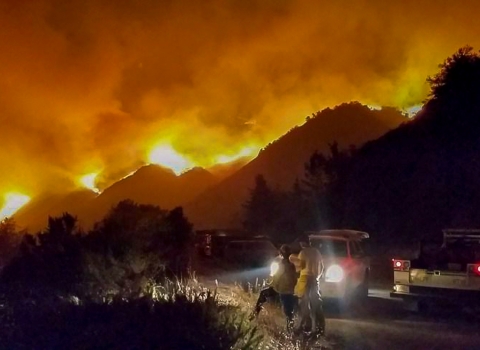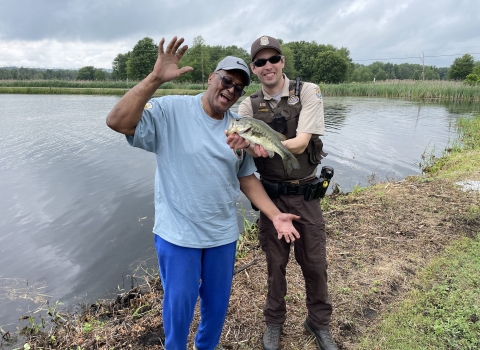Hiking through Pinnacles National Park in central California, you may be lucky enough to see the shadow of a massive wingspan or even catch a glimpse of a California condor soaring through the skies. The park is home to several endangered California condors, including condor 550, the condor featured in the U.S. Fish and Wildlife’s new poster commemorating the 50th anniversary of the Endangered Species Act.
California condors were listed as an endangered species in 1967. By 1982, only 23 condors existed in the wild. In 1987, all remaining wild condors were humanely captured and taken into care at the Los Angeles Zoo and the institution now known as San Diego Zoo Wildlife Alliance to launch a captive breeding program for the species. In the first 10 years of the California Condor Recovery Program, hundreds of condors were hatched and raised at multiple zoos in California, Oregon and Idaho and released into the wild. Today, more than 300 free-flying condors live in the wild.
“The California Condor Recovery Program is a shining example of how a species can be brought back from the brink of extinction through partnerships with states, Tribes, federal partners, non-profit organizations, and even other countries. Together, we are making a difference in this species’ future and conserving it for generations to come,” said Ashleigh Blackford, California condor program coordinator at the U.S. Fish and Wildlife Service.
In 2010, condors 317 and 318 found each other and became the first pair to nest at Pinnacles National Park. It was an exciting but worrisome moment because condor eggs in the wild were experiencing eggshell thinning issues.
“When biologists at the park noticed that 317 and 318 laid an egg, they talked to partners and decided to carefully remove the egg and replace it with an egg from the San Diego Zoo Wild Animal Park,” explained Alacia Welch, Condor program manager at Pinnacles National Park. “Doing so would increase the chances of the chick hatching and give researchers an opportunity to better understand the causes of eggshell thinning.”
The pair accepted the new egg as their own, and on March 24, 2010, the pair successfully hatched condor 550.
Long-time volunteer with the Ventana Wildlife Society, Tim Huntington, saw first-hand the attentive parenting behavior of 317 and 318 when 550 was hatched.
“During a hike at Pinnacles National Park, we got to the other side of the Steep and Narrow, and two birds flew over us. It was condors 317 and 318 swapping nesting and scavenging duties. We watched one of them circle down to where the nest was," he recalled.
Condors can be identified by tags placed on their wings by biologists. In California, the tags show the last two numbers of their three- or four-digit identification number and vary in color. For example, condors with blue tags (like condor 317) were born between 2003 and 2005 and are represented by the number 300. That means a blue tag with a 17 is condor 317. Condors with black tags, like 550, were born between 2009 and 2010.
About a month after hatching, park biologists entered the nest to check on the health of 550. They discovered that she had been exposed to lead, the leading threat to condor recovery.
In early May 2010, discussions between the biologists at Pinnacles National Park, Los Angeles Zoo and U.S Fish and Wildlife Service determined that 550 should be removed from the nest and taken to the Los Angeles Zoo for treatment. Condors receive chelation therapy to treat lead poisoning which involves providing medicine to the bird as a series of daily shots. Condor 550 responded well to the treatment and fully recovered. She stayed at the zoo and was raised alongside other young condors until 2011.
In August 2011, 550 was returned to Pinnacles National Park. She was held in an outdoor structure structure
Something temporarily or permanently constructed, built, or placed; and constructed of natural or manufactured parts including, but not limited to, a building, shed, cabin, porch, bridge, walkway, stair steps, sign, landing, platform, dock, rack, fence, telecommunication device, antennae, fish cleaning table, satellite dish/mount, or well head.
Learn more about structure to reacclimate to the environment and was released back into the wild in October.
In the years since, condor 550 expanded her home range beyond Pinnacles National Park and took up residence on the Big Sur coast. There, she paired with condor 652. They started nesting in 2020, and their first young made it to fledge, but died shortly after. They nested again in 2021, and successfully raised another young bird to fledging.
“We are excited to see condors 550 and 652 nesting again this year, and we’re hoping that another chick will hatch soon,” said Welch. “It’s so touching to observe how gentle condor parents are with their newly hatched, fluffy chicks, and it means so much to see them bringing up the next generation.”
In 2022, the annual condor population count identified 347 wild, free-flying condors. While this is a positive sign, the birds still face several threats, including lead poisoning and microtrash. Lead ammunition fragments upon impact, and if it is used for hunting wildlife, those fragments can be found in any remains left on the landscape. When condors and other scavengers feed on the animal remains, they ingest the lead fragments, which can result in lead poisoning and death. Microtrash refers to small bits of trash such as bottle caps, hard plastic shards or soda can tabs. Condors are curious birds, and sometimes adult condors bring microtrash to their chicks. The chicks eat the trash, but it cannot be digested, resulting in starvation and death.
“The best way you can help us recover condors is to use non-lead ammunition or collect your gut-pile when you hunt. Of course, always pick-up your trash when out in nature. These little changes can make a big difference,” said Blackford.
The Condor Recovery Program continues to address threats to the species in the wild and support captive breeding, release and monitoring of condors at field sites. The program also includes ongoing research, education and outreach. Avian influenza has become a new threat to the condor, and this program and its partnerships are more important than ever for the species’ recovery.
As for condor 550, “She still makes her way over to Pinnacles regularly just like all the other condors. In general, the central coast population of condors routinely traverses back and forth between the coast and the inland range that includes Pinnacles. It takes them less than an hour flight time to go between the two!” said Welch.
- Do you think you spotted a condor? You can check the tag number using the Condor Spotter locator.
- You can learn more about the U.S. Fish and Wildlife Service’s work with condors by visiting the California Condor Recovery Program webpage.
- Learn more about the condors at Pinnacles National Park
- See all the ESA at 50 Commemorative posters











